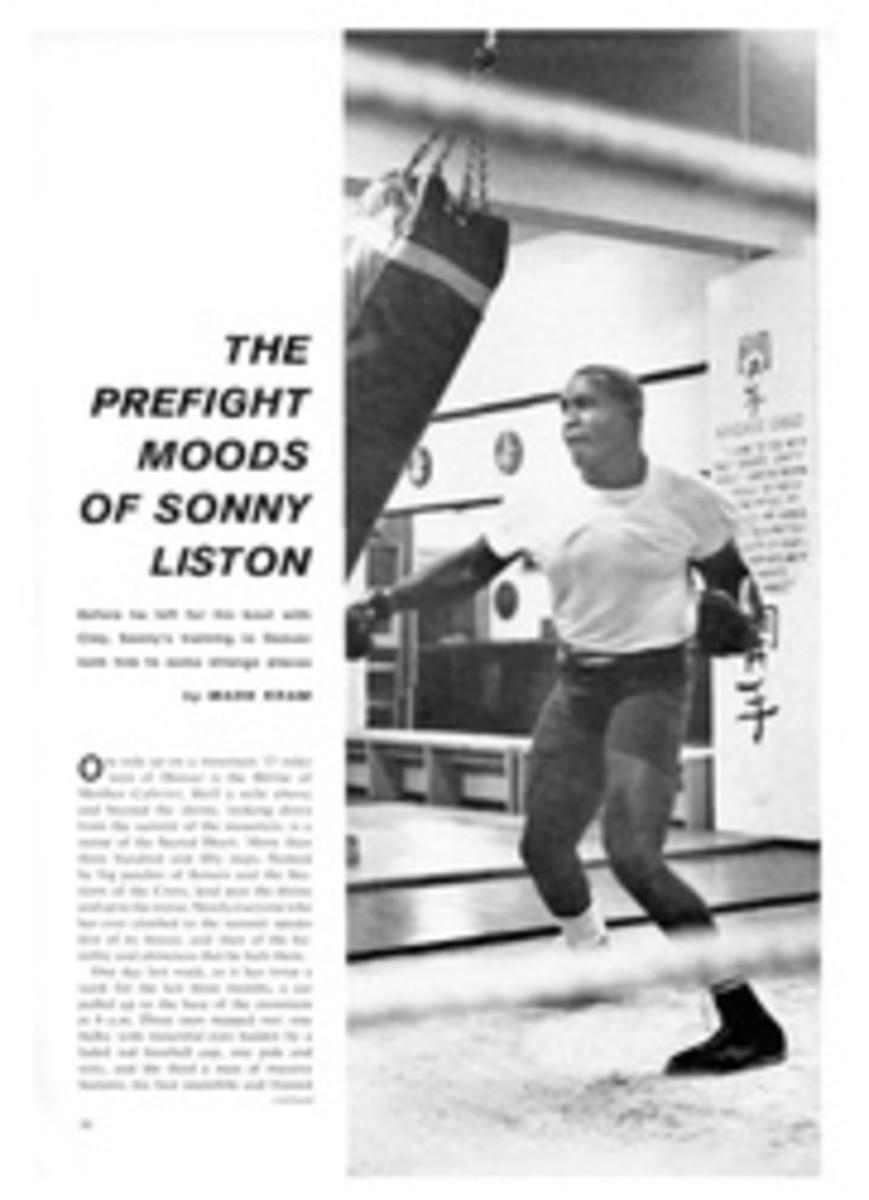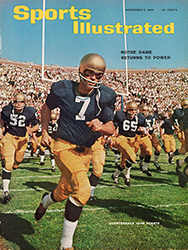
Short Happy Afternoon of Bart Macomber
A lot of years ago, just before World War I crossed the Atlantic, a football upset took place—perhaps the most upsetting upset in American college gridiron history. It was in the Minnesota-Illinois game on November 4, 1916, and it marked a high point in the career of Bob Zuppke, Illinois' coach. Bart Macomber, the Illinois captain and quarterback that day, had by then worn Zup's colors for more seasons and games than any other player.
Minnesota had a powerful team. Hal Hanson was at right half; Bert Baston, All-America end (and captain); Fullback A.D. Wyman and Quarterback C.T. Long. They had defeated South Dakota, 81-0; Wisconsin, 54-0; Chicago, 49-0; Iowa, 67-0; North Dakota, 47-7. The Gopher coach, Dr. Henry Williams, truly had assembled a steamroller.
The Illini were nursing a bruised pride from a disappointing season. They had lost to Colgate, 15-3; to Ohio State, 7-6: had got past Purdue, 14-7; but had been trimmed by Chicago, 20-7. Wisconsin, one of the Minnesota maulees, had held them to a scoreless tie. Much of the betting money was asserting the Gophers would score 40, 50 and even 60 points. If you had wanted to wager that Illinois would at least score, you would have found some long odds there as well. Ring Lardner wrote a humorous letter, pregame, to Zup and the Illini in his newspaper column. In it he urged them, as a friend, to forget the trip to Minneapolis and just stay in Chicago and see a play. The lucky players, he said, were those on crutches, since they would not have to face the northern monster.
The Illinois team took the train from Champaign a little after noon on Thursday. They dozed, played cards or viewed the passing scenery. There was no steam, no fire, no win-this-one-for-sure. The notion itself was insane. Bob Zuppke puffed on his cigar and looked moodily out the window.
"Zup was a near-martinet on the practice field," Bart Macomber recalls, "and wanted it strictly understood he was boss there at all times. He believed in thorough practice, monotonous drill, with perfection the goal. He was quick to criticize errors, but rarely given to praise. Off the field he was a mild, almost bland individual, about 5 feet 7, 165 pounds, light hair and complexion. Rather of the professor type, if you know what I mean.
"He earned a basketball letter at Wisconsin; football there amounted to four years of scrub. He taught history and coached football at Oak Park High, near Chicago. I believe he made about $2,500 at that job while I played for him there. We had three years undefeated, then he was offered the Illinois coaching post—at an increase in salary, of course. Our last year at Oak Park, the class of 1912, two on that team went on to All-America. They were Milton Ghee at Dartmouth and myself at Illinois. A third member of our team, Pete Russell, made All-Western at Chicago U."
The train got to Minneapolis Friday morning. Zup's boys went early to the enemy stadium to run some signals and look over the plant. All noticed with relief that the ground was not frozen. Minnesota's tackling was murderous enough on softer soil.
Bart Macomber recalls it this way: "We began practicing. We were so nervous and upset we could not even hang onto the ball. Coach Bob soon saw that the whole effort was useless. He was afraid it would only demoralize us for the next day. So he called practice off. He waited a bit for full attention and said, 'If you are going to be slaughtered tomorrow, you might as well break training and have a good time tonight.' He told us to try to relax, to eat and drink whatever we liked, maybe see a show. We trooped back to our hotel, the Radison. The whole squad of 25, including coaching staff, napped and idled the afternoon away. That evening we went on the town. No one counted the drinks or the beers. We ate large dinners and moved the celebration over to a burlesque house. There was no bed check."
Kickoff time was two o'clock, Saturday. Twenty-five thousand chop-licking Gopher fans sat in the wooden stands, an impressive crowd in 1916. The day again was overcast but dry, with temperature in the mid-40s. Illinois took the field at 1:30 and moved the ball around for several minutes. Then the Illinois players stood in awe as Mighty Minnesota, three deep, came charging out. Somebody said that the Gophers did not look so big, after all.
Minnesota won the toss and chose to receive. Macomber kicked off to Shorty Long in the end zone. Long fumbled, recovered, moved to the 15. Joe Sprafka carried first and several linemen hit him for no gain. Illinois continued to hold, and A.D. Wyman had to punt to Dutch Sternaman, who made about 10 yards. Robert Knop, Illinois fullback, was assigned to hit the line at center, but the Gopher front wall was impassable. Then Macomber called for a spread formation, employed in this game for the first time by any team. Linemen took up their positions 10 yards apart, the backs doing the same to form a distended box. The opposing linemen and defensemen simply did not know, in the sudden confusion, whether to play opposite the man or the space. Sternaman collected Macomber's pass for a 25-yard gain. Then, behind perfect interference, the Illinois ballcarriers rang up two first downs to the Minnesota five. An offside penalty put the ball on the one-yard line, Macomber went over, then kicked goal.
Minnesota received again, very sure of itself. Illinois held for the first two downs. The Gophers then hauled out their formidable pass combination, Wyman to Bert Baston. One of Zup's men grazed Wyman's passing arm, resulting in a shot that was wobbly and slightly off line. Reynold Kraft, Illini left end, intercepted in midfield. With spectacular interference, Kraft raced to a touchdown. Macomber converted and the half ended, Illinois 14, Minnesota 0. The upset had begun. Macomber again:
"I can't emphasize enough, really, the inventive skill, the sheer football genius and insight that Zup possessed. He was always thinking up, working out, new tactics and ways of improving old ones. That spread formation, for instance, was his invention. We practiced it a lot that season, rather openly. Scouting was not too prevalent at that time. Innovations? The word should be synonymous with Zuppke. Do you know that he thought up the huddle and was first to use it? In later days he told the writers it was not mainly, as commonly supposed, his answer to crowd noise, although that did make signals hard to hear. He felt it was a logical extension of technique because of increasing complexities of the plays coming into use. Many of them simply demanded the clustering of players in order for everyone to know who does what.
"Then he came up with an extension of the same idea: to call two, or three, or more consecutive plays from a single huddle or signal. Zup taught me a valuable trick of another kind. I was instructed, after my kick or pass, to move quickly to the side of the field where the football went. The player receiving or intercepting had me going straight for him as a defenseman. Out of bounds was on one side of him, our heavy tacklers were on the other."
Between halves, Zuppke warned that the Gophers would come back strong. He was right. The second half was mostly all Minnesota, now moving powerfully with perfect line plays. Three first downs took them to the visitors' 35. Line charges again, plus a 15-yard penalty against Illinois, set up a TD from the five. Baston kicked goal. A punting duel ensued, until Sternaman fumbled a catch on the five and had to fall on it behind his goal line. Score: Illinois, 14; Minnesota, 9. The Gophers threatened repeatedly, but timing seemed to suffer as they became increasingly anxious to get another score on the board. There was a crucial fumble, and, again, a saving interception.
"Zup had told me to stall as much and as long as I could get away with it," Macomber says. "I killed all the time I could as those angry fans screamed at me with time running out. My shoes needed tieing, one, then the other. Shoulder pads wanted adjusting, or something was wrong with the way they were laced. I miscalled signals a few times. The whistle was blown on me twice, each time for a five-yard penalty. The stalling rules then were not too strict."
It all led to what Sportswriter Harry Grayson called, years later, "the greatest football upset of all time." Minnesota, according to Macomber's recollection, used some 33 players. For the Illini the same 11 men played 60 minutes of hard ball. The final score was 14-9.
An Illini publicity man, Mike Tobin, was in New York that day on his wedding trip. He telephoned for the game results. The first newspaper he called told him the lopsided score. Tobin was pleased, but then puzzled and even skeptical. He figured that the eastern papers did not know one team from another—especially midwestern teams—and that the paper had simply reversed the score. It was not until he read a full account of the game in the paper later that he believed Illinois had really won.
For Bart Macomber, who is nowadays a retired businessman in Portland, Ore., the upset remains a monument in his memory to the ingenuity of Bob Zuppke. "Zup had so many tricks up his sleeve or in the mill." he says, "one cannot recall them all."
PHOTO
MACOMBER WAS ILLINI CAPTAIN AND QUARTERBACK

